Online shopping = mailroom challenges
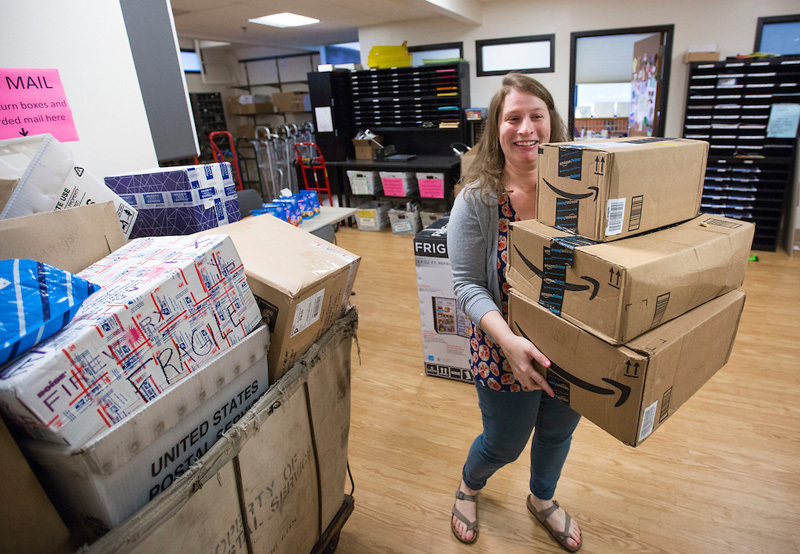
Jennifer Rosen, Maple-Willow-Larch hall desk supervisor, sorts through newly arrived packages in the MWL mailroom. Photo by Christopher Gannon.
College students receiving packages at school -- whether filled with cookies from Mom or a forgotten sweater from home -- once were rare events. A couple times a semester, students might discover brightly colored slips of paper in their college mailboxes, notifying them of packages awaiting pickup.
Times have changed.
The advent of technology, the convenience of online shopping, plus the lure of free shipping by some companies means more and more packages are stacking up in residence hall mailrooms.
"Students can click on anything they want, whenever they want," said Jennifer Rosen, hall desk supervisor at Maple-Willow-Larch (MWL) residence halls.
By itself, students' predilection for online shopping challenges mailroom staff, but add to it the fact that more students are choosing to live on campus, and that means Iowa State's busy residence hall mailrooms are getting busier every year.
By the numbers
Here's a closer look at the numbers, provided by the department of residence. These statistics don't include students living in university apartments; those packages are delivered directly to the students' assigned mailboxes.
- 7,430: Students living in residence halls (fall 2015)
- 110,501: Packages received at campus residence halls during the 2015-16 academic year
- 6,997: Students living in residence halls (fall 2011)
- 61,971: Packages received at campus residence halls during the 2011-12 academic year
- 48,530: Increase in packages shipped to residence hall students from 2011-12 to 2015-16
- 15: Packages (approximate) per residence hall student received during 2015-16
- 48: Part-time students and community advisers (CAs) who manage packages in the Maple-Willow-Larch and Union Drive Community Center (UDCC) mailrooms, the two largest on campus. More than 140 CAs work in residence hall mailrooms across campus.
Packages aplenty
Rosen said student perks like free Amazon Prime make online ordering even more enticing. She also noticed a significant rise in the number of boxes from subscription services, like Ipsy and Birchbox, which offer personalized monthly make-up and beauty care products.
"Tons of people order these subscriptions," she said. "It seems like once a student starts getting them, then all their friends want them, too, so we just keep seeing more and more of the same boxes in the mailroom."
Peak periods
Jordan Burkhart, former mailroom supervisor at UDCC, which serves students in Martin, Eaton, Friley and Helser halls, said package deliveries ebb and flow.
"The beginning of each semester we can expect a high amount of traffic -- upwards of 350 packages a day," Burkhart said. "It's usually residents ordering textbooks, things for their new spaces and family sending care packages to start the year."
He said package traffic also significantly picks up the week after Black Friday, two weeks before finals and Valentine's Day week.
On a typical day, MWL receives 60 to 120 packages, and UDCC accepts 70 to 90 deliveries. United Parcel Service (UPS), the United States Postal Service and FedEx deliver most packages.
Working smarter
The department of residence understands the growing demand on residence hall mailrooms. For example, a new electronic package tracking system was implemented a few years ago, and any residence hall renovations or new construction projects yield conversations about increasing mailroom efficiencies. But to serve students effectively right now, employees are working smarter.
"We try to have deliveries at different times," Rosen said. "UPS comes in the morning, the post office comes around lunch time. That gives us time to log everything in before the next truck arrives."
Burkhart said the UDCC mailroom staff has shuffled schedules and assigned more employees to assist students during the busiest times, especially 10 a.m. to 1 p.m., Monday through Friday. Some mailrooms also have extended their hours.
But what if the shoes are too small or the futon is too big to fit through the door? (Yes, MWL has received futons in the mailroom.)
"We don't accept returns," Rosen said. "It's just too much for us to handle." Instead, she and her staff direct students to Copyworks, 104 Welch Ave., which assists with package returns.
No end in sight
Online shopping likely will remain popular well into the future, so what's a mailroom employee to do?
"Moving forward, we will continue to adapt our mailroom spaces and procedures to accommodate the increases," Burkhart said.
Classic look for an oft-used lawn
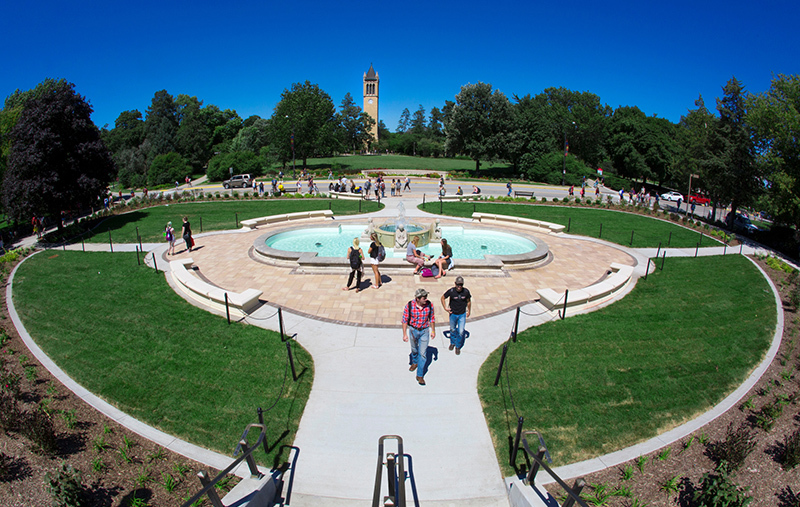
Photo by Christopher Gannon.
Following a summer of black dirt and weather delays, the renovated fountain plaza on the Memorial Union's north lawn reopened with the new academic year.
The renovation, part of President Steven Leath's three-year campus beautification initiative, partners with last summer's university wall on the north side of Union Drive to create a photo-worthy arrival point on central campus. Phase II included new grading and sidewalks that created an accessible north entrance to the MU and to Christian Petersen's iconic Fountain of the Four Seasons sculpture from all directions; pavers; stone benches and new plantings, sod lawn and irrigation system. And while it was turned off this summer, art conservator Francis Miller completed some restoration work on the 75-year-old fountain.
A public celebration of the new plaza and the restored sculpture, postponed from Aug. 31, will be rescheduled.
Regents to vote on funding request for vet diagnostic lab
A five-year, $100 million state appropriations request to replace the ISU veterinary diagnostic laboratory (VDL) is on the agenda when the state Board of Regents meets Sept. 7-8 at the University of Iowa. Funding for the estimated $124 million project also would include $20 million in private gifts and $4 million in university funds.
The regents face an Oct. 1 deadline to submit operating and building funding requests to the state for the fiscal year that begins July 1, 2017. The board's top priority for next year is a $15 million request to address deferred maintenance, fire safety and energy conservation needs at all of the regent institutions and provide infrastructure for Iowa Public Radio. Over five years (FY 2018-22), the board's funding request to the state for this category totals $100 million.
A live audio stream of all public portions of the meeting will be available on the board's homepage. An agenda and supporting documents also are online.
Iowa State's VDL is the only full-service and fully accredited one in the state. Since it opened in 1976, its employee base has grown from 11 faculty and 20 staff to 25 faculty and 120 technical staff processing more than 75,000 submissions in space that hasn't changed. In addition to providing more space for modern diagnostic technologies, a new facility will meet biosafety and biocontainment requirements. The board will vote to request a state commitment of $20 million per year in fiscal years 2018-22.
Because of previous multiyear legislative commitments, in FY18 Iowa State also will receive $19.5 million to complete two biosciences facilities (Bessey addition and new teaching/research building) and $9 million to begin the Student Innovation Center south of Sweeney Hall.
The proposed request for increased state support for Iowa State's FY18 operating budget is 2 percent. This includes the education, economic development and agricultural appropriations that support operating expenses. If the 2017 Legislature were to approve the request, it would add $4.8 million to this year's $708 million operating budget.
In response to Gov. Terry Branstad's request for two-year appropriations requests, at this early date Iowa State also will request a 2 percent operating appropriations increase for FY19.
Vet Med café, chilled water expansion
Iowa State will present a schematic design and revised budget ($3.45 million, previously $1.85 million) and seek board permission to begin a project at the College of Veterinary Medicine to relocate and expand the Gentle Doctor Café and commons. This includes a second-floor addition to the north side of the college and renovation of adjacent space. The proposed commons, with a capacity of 50 people, is designed as flexible space for collaborative academic uses, meetings and special events. Construction would begin in May and last about 16 months. Food service would be maintained at the college during construction, likely a reduced menu in a temporary location. College funds ($3.35 million) and private gifts ($100,000) would pay for the project.
Iowa State also will seek final approval from the board on a $22 million project to expand the campus' chilled water (air conditioning) capacity on the north and west sides of campus in response to recent building projects and anticipated growth in the next 10 years. Specifically, it would add two chillers and one cooling tower to the north plant (Kooser Drive), replace the underground electrical line between the power plant and north plant to operate the chillers, and install new underground chilled water pipes near Kooser and Bissell Road. The proposed funding sources are utility revenue bonds ($18.75 million) and utility funds ($3.25 million).
In other business, Iowa State will seek permission to:
- Award an honorary Doctor of Science degree to alumnus and Orange City native Dennis Muilenburg, chairman, president and chief executive officer of The Boeing Company, for "outstanding contributions to the advancement of science and technology, particularly in the field of aerospace engineering." Muilenberg received a bachelor's degree in aerospace engineering from Iowa State in 1986, and a master's degree in aeronautics and astronautics from the University of Washington (1990). Faculty members in the aerospace engineering department nominated him for the honorary degree.
- Promote one more (previously tenured) faculty member, bringing the total number of actions at Iowa State for 2016-17 to 59, (58 cases were presented in April).
- Name the future indoor tennis practice facility for 1956 alumnus, Des Moines attorney and longtime ISU supporter Bruce McKee. The building naming would be effective when the university exercises its option to purchase the facility prior to or at the conclusion of a five-year lease the board approved in April with developer Dickson Jensen. McKee provided a lead $0.5 million gift toward the purchase of the estimated $2.5 million facility, which is under construction on South Dakota Avenue south of the basketball practice facility.
Meet Clayton Johnson, Professional and Scientific Council president
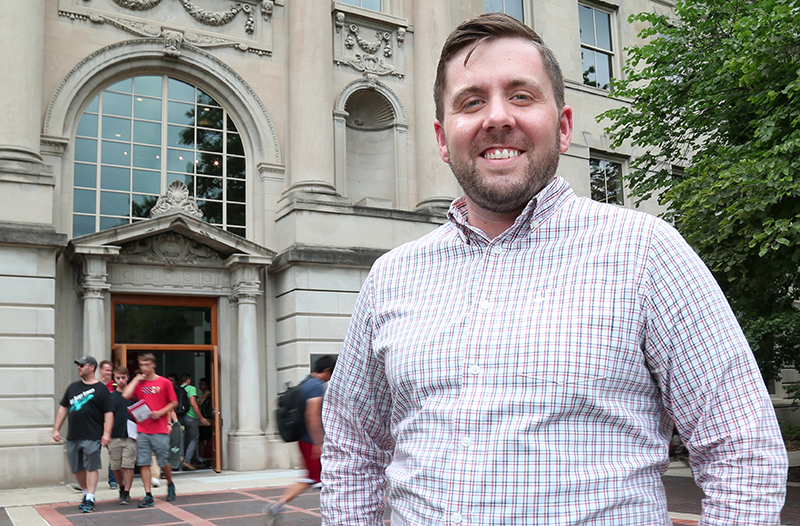
Photo by Christopher Gannon.
Position: Academic adviser, Engineering student services
Year hired at ISU: 2008
Contact: 294-5493, cjjohn@iastate.edu
Describe your work
I like to describe myself as a campus liaison for students. I'm the first contact for students with questions about classes, primarily, but I can also connect them with campus resources. I also coordinate the learning communities within our office (approximately 450 first-year students). With that, we have upper level peer mentor students (nearly 30).
What one word would you use to describe yourself?
Curious. One of the things I love about working at Iowa State is that we're surrounded by people who are always trying to learn, discover and grow.
What interests do you have outside of work?
My undergraduate degree is in performing arts, so I do a lot of work with local choral and theater organizations. I do a lot of volunteering with those organizations as well.
What strengths do you bring to the council presidency?
I have a long history and knowledge of where we've come from in council. I have good connections around campus and can relate with people easily. I have good communication and people skills -- as an adviser I think that's necessary -- which carries over well to council. I enjoy leading a team and, through that leadership, seeking input and group interactions. Our executive team this year is incredibly strong and knowledgeable -- it's going to be a great guiding force.
What is your top priority?
I really want to be communicative and respectful to our constituents and to recognize that we, as council, are here to serve and be responsive to concerns, issues and questions.
What challenges face the council?
I think a major one is the uncertainty around the new FLSA (Fair Labor Standards Act) requirements. We have a lot of concerns about that already. And, in general, the classification and compensation review that's going to happen -- making sure that P&S staff are represented in that process, which is on a fairly quick timeline.
What would you like to tell the staff you represent?
Professional and Scientific Council is here to serve as an advocate and a representative for P&S staff -- so use us! Talk to your representative, talk to me. We're here to help.
Meet Jonathan Sturm, Faculty Senate president
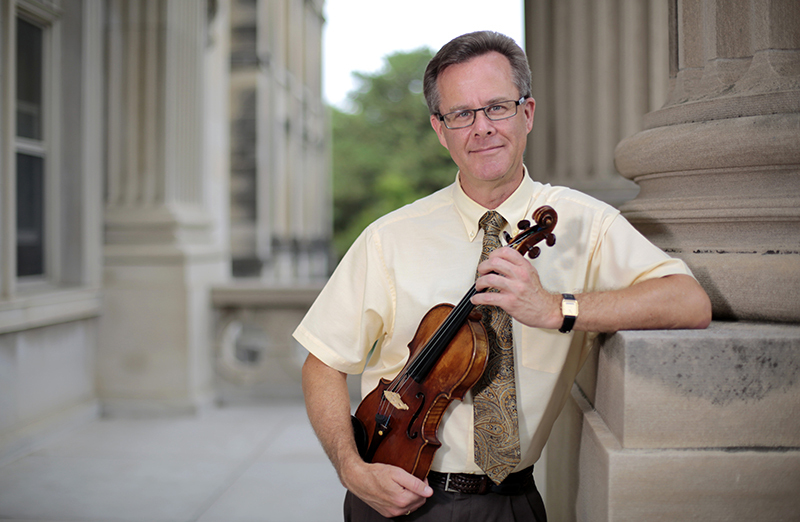
Photo by Christopher Gannon.
Position: Professor, music and theatre department
Year hired at ISU: 1998
Contact: 294-7399, jsturm@iastate.edu
Describe your work
I am a musician across many aspects of the discipline. As a professor of music at ISU, I teach music history to majors and nonmajors. As concertmaster of the Des Moines Symphony for 25 years, I perform on the violin. As violist in the Ames/Amara Piano Quartets, I have toured the United States and other countries performing classical chamber music -- in 2003, the Ames Quartet was the first American chamber ensemble to be invited to Cuba since its 1959 revolution. I also have collaborated with Parks Library staff and assumed various administrative responsibilities over my time as a Cyclone.
What one word would you use to describe yourself?
I am a Renaissance man. I enjoy challenging myself to be strong in as many areas of knowledge and practice as I can be.
What interests do you have outside of work?
I mostly enjoy my struggles with the game of golf, and I enjoy tasting and talking about fine wines and cheeses.
What strengths do you bring to the senate presidency?
I have served as chair of the Liberal Arts and Sciences caucus on senate, and on several committees over the past six years. But, perhaps more to the point, I am a good listener and bring a strong desire to be a connector between faculty and administration over the next year.
What is your top priority?
I hope to bring greater awareness to faculty, staff and students about the Responsible Conduct of Research and to increase the cogency of our voice for the free and open access of faculty and student research data and publications. That said, I also am passionate about advancing a welcoming and inclusive educational climate on campus, and I will work with administration, faculty, staff and students to make progress in this important area of campus climate during the next year.
What challenges face the senate?
One challenge I hope to help reduce over this next year is bringing to the general public and also the legislature awareness about just how hard faculty and staff work at ISU. Most faculty do 12 months of work in the nine months for which they are paid, and then use the unpaid three months to further advance their research and national reputations. Faculty work-weeks of 50 to 70 hours are not unusual, and I have worked those hours myself for many years. The public at large needs a clearer understanding that ISU, in fact, provides a superior value for the public dollars invested in it. Faculty teach and conduct research at extremely high levels and make a heroic effort to succeed at their work. This same description also applies to our staff.
What would you like to tell the faculty you represent?
To me, a university is a body of scholars who have collected -- almost always in the presence of a great library -- to move knowledge forward. As we work together for a better university, we must always remember that we are here for knowledge -- the discovery and transfer of knowledge is our passion and our career. All other work should serve this fundamental drive, for in this emphasis we will most efficiently move humanity, society and culture forward -- creating a brighter future for our children’s generation. Let us do our work and create our policies so that all members of the ISU community can pursue the increase of knowledge to the best of their individual abilities in a stable, welcoming, yet vibrant campus.
Links that do the job
Links are the spidery foundation of the web, but some don't do their jobs. They blend into the page, almost hidden. Their labels are vague. They entice you into a click and, suddenly, you're downloading a 50-page PDF.
For those who already have difficulty accessing websites, such links are more than annoying. They pose a real barrier. Fortunately, it's fairly easy to turn difficult links into accessible ones. Here's how to make your links work for everyone.
Don't put "link" in a link
| Don't: | Link to Iowa State homepage |
| Do: | Iowa State homepage |
Screen readers, used by people who are blind and those with low vision, always announce links before reading them. In the first example above, a screen reader would say, "Link, link to Iowa State homepage." In the second, the reader would say, "Link, Iowa State homepage." "Link, link" quickly becomes tiresome, particularly, if there are dozens of links on a page.
Links must make sense out of context
| Don't: | For the list of ISU majors, click here |
| Do: | List of ISU majors |
| Don't: | Iowa State students choose from 100 majors |
| Do: | Students choose from 100 Iowa State majors |
Read in context, the "don't" examples seem to work. However, many screen reader users save time by skipping most of the text on a site and skimming from link to link. In a long list of links, "click here" doesn't mean a thing and "majors" is a bit obscure. "List of ISU majors" or "100 Iowa State majors" is more straightforward.
If a link is going to download something or open a new window, say so
| Don't: | ISU Strategic Plan FY 2017-2022 (PDF) |
| Do: | ISU Strategic Plan FY 2017-2022 (PDF, 18KB) |
| Don't: | ISU Office of Admissions |
| Do: | ISU Office of Admissions (opens in new window/tab) |
Clicking into a download (for example, a PDF, Word doc, Excel file or PowerPoint) when you're expecting to see a website is annoying. For screen reader users, it's also disorienting. They may find themselves on a new page with no way to get back. It's also polite to include the size of the download within the link.
If a link takes users to a downloaded file or opens in a new window (or tab), include this information within the link title. If it's outside the link title, those using screen readers may never see it.
Avoid using the URL as the link title
| Don't: | http://www.vpresearch.iastate.edu/en/for_industry/business_incubators_offices_and_laboratories/ |
| Do: | ISU Business Incubators, Offices and Laboratories |
In the first example, a screen reader is going to painstakingly read every letter and dot in the URL. Unless there's good reason to use the URL as the link title, use something that's a little easier on the eyes and ears.
Ensure that links can be easily seen
| Don't: | Facts about Iowa State |
| Do: | Facts about Iowa State |
The gold standard is to underline links whenever possible. Colored text also signifies a link, but color alone won't necessarily pass the accessibility test. The link must stand out in some other way. If it's not underlined, for example, it should be boldfaced, italicized or be sufficiently different in lightness or hue from normal text. Specifically, the colored link should have a contrast ratio of at least 4.5:1 on normal text (generally about 14 point) when compared to non-link text. Of course, there needs be be enough contrast with the background as well for easy viewing. Don't trust your own eyes on these specs. Run the colors through one of the many online color contrast checkers, such as WebAim Color Contrast Checker and Luminosity Colour Contrast Ratio Analyser.
Accessibility assist
Got questions? Contact web accessibility coordinator Zayira Jordan, zjordan@iastate.edu, 294-0982.
Ensure that links can be accessed via the keyboard
If links only can be accessed by a mouse or trackpad, they are inaccessible. You should be able to click the keyboard tab to move through your website links. If that doesn't work, contact your web developer for a fix.
Related stories
- Accessible PowerPoints are on students' wishlist, March 30, 2017
- Captioning, with an assist from YouTube, Jan. 5, 2017
- Well formed forms, Oct. 20, 2016
- Links that do the job, Sept. 1, 2016
- Color your website accessible, July 21, 2016
- How to create accessible Word docs, June 23, 2016
- The art of alt text, June 9, 2016
Fall for Cyclone colors
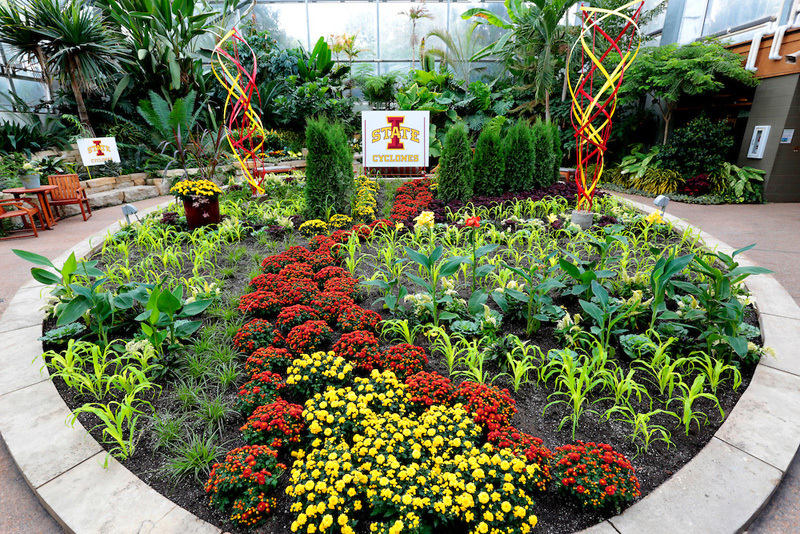
Photo by Christopher Gannon.
The Hughes Conservatory at Reiman Gardens is awash with cardinal and gold colors to kick off autumn and the Cyclone football season.
"Cardinal & Gold" is the latest exhibition showcasing Reiman Gardens' 2016 theme, Color. Fall garden mums, ornamental millets, coleus, flowering kale, bromeliads and dwarf red grasses are juxtaposed among the conservatory's permanent trees and plants to help usher in fall.
Cyclone fans also will take note of two, 10-foot-tall Cyclone pride sculptures and fountains, rising from the center flowerbed. Other Iowa State items scattered throughout the exhibit reflect a tailgating motif, complete with planted grills, flags, pillows, Cyclone-themed strings of lights, and cardinal and gold containers.
"Cardinal & Gold" is on display through Nov. 13. Reiman Gardens is open daily 9 a.m. to 6 p.m. through Sept. 5 (9 a.m. to 4:30 p.m. after Labor Day). General admission fees apply.
